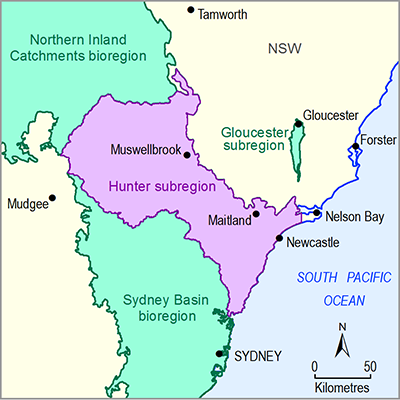Streamflow in the regulated Hunter subregion downstream of dams has been smoothed out somewhat by dam release management and river regulation. More consistent flows have led to less variable hydrographs in alluvial bores, probably as a result of greater stream leakage maintaining aquifer water levels (EPA, 2013). Mining operations that lead to an increase in leakage from the aquifer and result in increased river leakage, may lead to lower local salinity in the alluvium (Australasian Groundwater and Environmental Consultants, 2013, p. 38, Figure 15).
In the unregulated section of the Hunter River alluvium, the alluvial system is considered highly connected to the surface water system, and is managed as the same unit (DWE, 2009). Groundwater discharge is considered a portion of stream baseflow (Kellett et al., 1989; NSW Department of Planning, 2005). Total discharge from alluvium to river accounted for two-thirds of all discharge fluxes in a model of North Wambo Underground Mine, even with the river bed conductance set at a relatively low value (Heritage Computing, 2012). An increase in river salinity has been linked to reduced river flows and increases in inflow of saline water from deeper strata (Kellett et al., 1989, see p. 37, Figure 20; Biswas, 2010; EPA, 2013). When regulated or natural river flows are low, the stream salinity increases toward the salinity of the local alluvial aquifer and the proportion of baseflow can increase to near 100% (e.g. Biswas, 2010, p. 139, Figure 5.2).
Baseflow separation using digital signal processing methods (Lyne and Hollick, 1979) has been applied to the daily hydrograph of streams and river reaches within the Hunter subregion. They consistently estimate that on average around 50% of streamflow is discharge from the alluvial aquifer (44% to 63% from Biswas, 2010,Table 6.2, p. 191; 39% to 66% from Biswas, 2010, Figure 7, Section 1.1.5). Locally streams may be net gaining or losing (EPA, 2013), and the proportion of baseflow in the Upper Hunter varies both along the length of a reach and with the time of year (Biswas, 2010).

